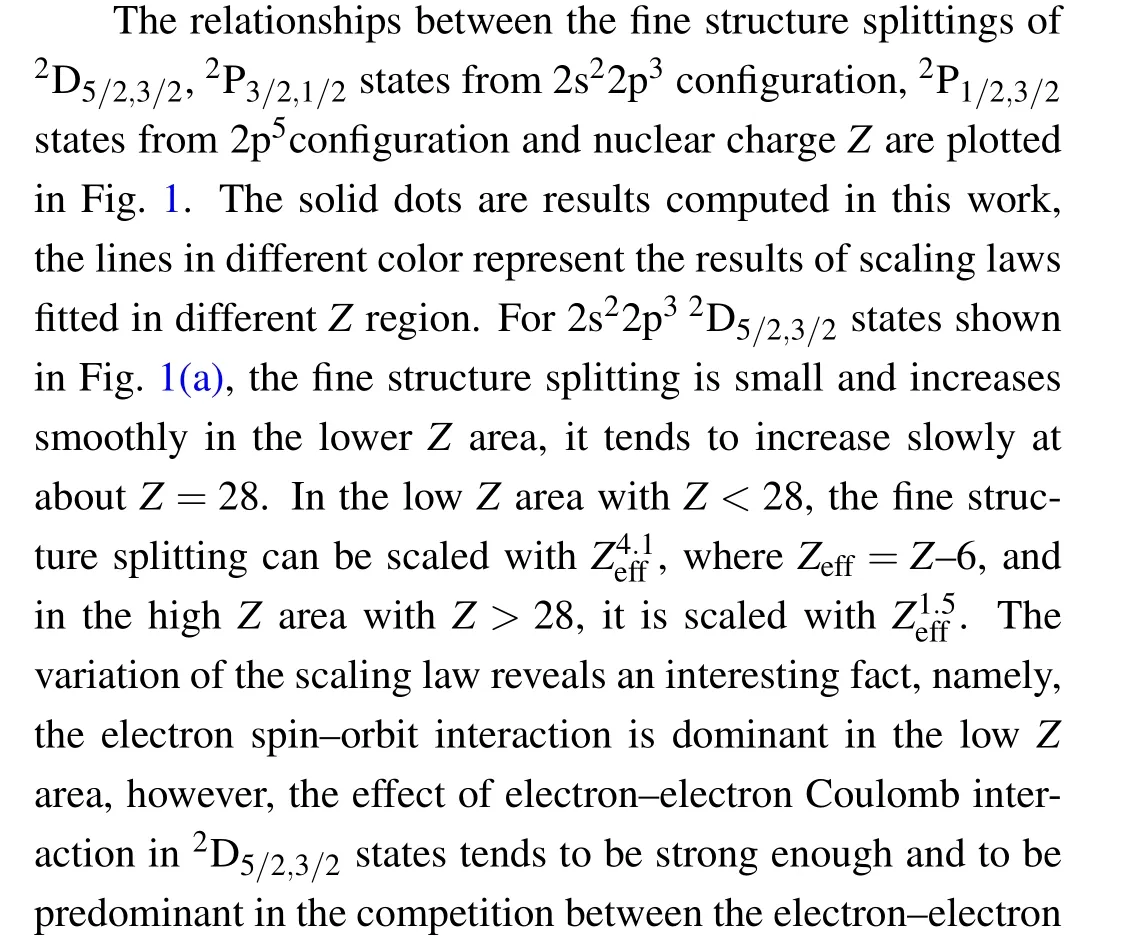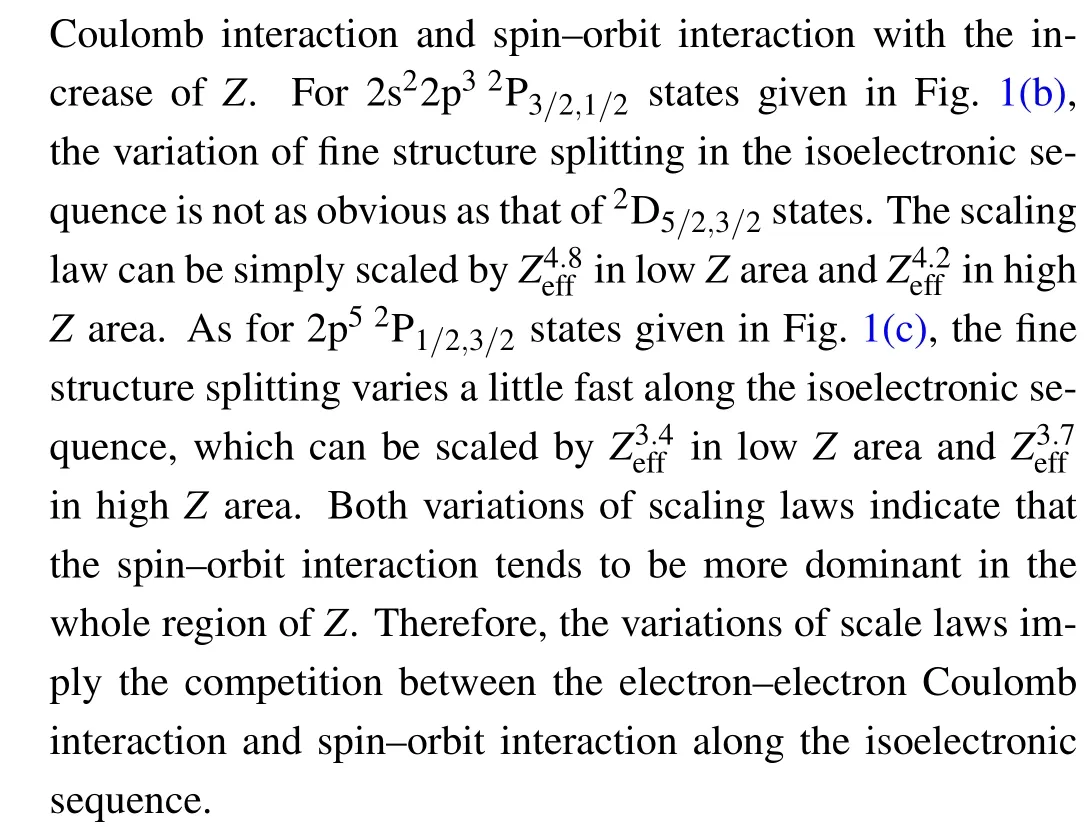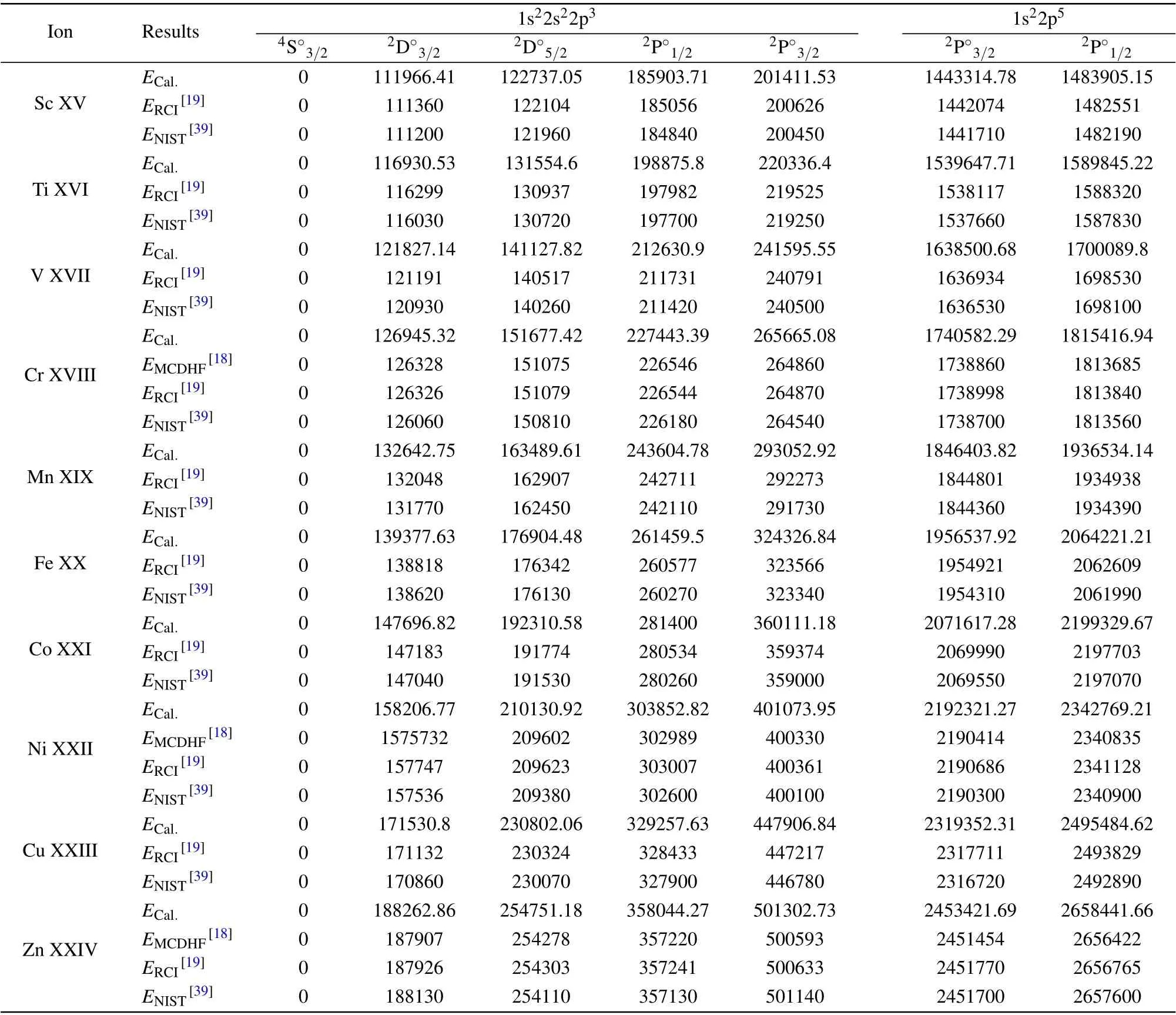Energy levels and magnetic dipole transition parameters for the nitrogen isoelectronic sequence
2022-09-24MuHongHu胡木宏NanWang王楠PinJunOuyang欧阳品均XinJieFeng冯新杰YangYang杨扬andChenShengWu武晨晟
Mu-Hong Hu(胡木宏) Nan Wang(王楠) Pin-Jun Ouyang(欧阳品均)Xin-Jie Feng(冯新杰) Yang Yang(杨扬) and Chen-Sheng Wu(武晨晟)
1School of Physics and Electronic Technology,Liaoning Normal University,Dalian 116029,China
2Institute of Applied Physics and Computational Mathematics,Beijing 100094,China
Keywords: energy level, magnetic dipole transition, transition rate, scaling law, nitrogen-like ions, multicongfiguration Dirac-Fock(MCDF)method
1. Introduction
The growing demands of spectra data for highly charged nitrogen-like ions along isoelectronic sequence, such as energy levels,radiative transition wavelengths,line strength and transition rates, have become urgent in astrophysics. The reliable data can motivate the further analysis of the observed spectra containing the information about structure, physical conditions, chemical abundances and transition region of astrophysical objects.[1-6]On the other hand,a wide comparison among the high-resolution spectra obtained from various astrophysical sources shows that most part of the emission and absorption lines are generated from iron ions,including the Fe XX ion,the nitrogen-like ion studied mostly.[7-10]It is unquestionable that the thoughtful analysis and modeling on these spectra are very helpful in profound comprehension of astrophysical sources’structure,feature and processes of evolution.The reliable spectra data of nitrogen-like ions also play significant roles in the field of plasma diagnostics.[11-13]In many cases,it is difficult to obtain plasma parameters directly,accurate and abundant spectra data can provide valuable reference for research on characters of plasma,such as electron temperature, electron density distribution and influence from environmental and operation conditions. Moreover,accurate spectra data are important not only for distinguishing the blending lines emitted in collisionally ionized plasma but also for understanding the spectra lines produced in photoionized plasma.
During the past decades, the great comprehensive theoretical research on highly charged many-electron system has been employed, a great deal of valuable atomic basic data of nitrogen-like ions have been obtained with different methods. At the first stage, the electric dipole (E1), electronic quadrupole (E2) and magnetic dipole (M1) transitions of nitrogen-like ions withZ= 10-30 between 2s22p3, 2p4and 2p5configurations have been investigated with the stationary second-order many-body perturbation theory (MBPT), in which the relativistic corrections are considered in the Breit-Pauli approximation.[14,15]With the development of the iron project, atomic data for Fe XX including the energy levels,oscillator strengths,line strengths and radiative transition rates of dipole allowed and forbidden transitions are presented with the multiconfiguration Dirac-Fock (MCDF) method and the relativistic Breit-PauliR-matrix (RBPR) method,respectively.[16,17]The computations on wavelength and oscillator strength of transitions from 1s22s22p23s, 1s22s22p23d,1s22s12p33p configurations to 1s22s22p3configuration in Fe XX ion are also performed using the configuration interaction Dirac-Fock and Dirac-Fock-Sturm method.[18]The results mentioned above have limited precision and cannot accommodate the special demands of observations. In response to the advances in measurements, energies and transition properties for states of 2s22p3, 2p4and 2p5configurations in nitrogenlike ions are evaluated with the relativistic configuration interaction(RCI)method and extensive multi-configuration Dirac-Hartree-Fock(MCDHF)method.[19,20]As for 2l5and 1s2l43l'configurations,energies with high accuracy are predicted with a combination of RCI method and MBPT method in FAC code, and complete and consistent sets of energies and transition parameters involving then= 3, 4 levels in nitrogenlike ions are given with the same method as an in-depth research.[21,22]However, the research on nitrogen-like isoelectronic sequence is not satisfying at all, the results of energy level structure and transition property calculated previously are not accurate to meet the special requirements[23]and the results obtained latter are not complete. In addition,the research on scaling laws along the isoelectronic sequence has attracted more attention because of their regularities and practicalities.[24,25]The scaling laws describe the relationship between the energy levels, transition rates, line ratios and the nuclear chargeZ,they also reveal the competitions of physical interactions in different procedures. Therefor,it is significant to carry out research on scaling laws,which contain more detail of dynamical processes and also provide an efficient way to obtain other values interested via interpolation method.
Among the various theoretical methods and numerical techniques used to carry out approximate computation,MCDF method has made considerable progresses to meet the increasing demands of different calculations, its approximation of the calculation on atomic stationary states and transitions is described in detail in the literature and not repeated here.[26-29]MCDF method has become more and more important in higher precision calculation. In general, it is indispensable to accomplish the accurate study on energy structure and property of radiative transition without efficient program.Based on the MCDF method, GRASP program is a convenient program provided to perform rigorous calculations on energy levels and transition properties,in which the relativistic effects and electron correlation effect are taken into account adequately. GRASP has been used in a wide range of applications since its public release, its reliability and accuracy have been verified with a large amount of results obtained.[30-35]In this work,we apply the MCDF method to study 1s22s22p3and 1s22p5configurations for nitrogen-like ions withZ=21-30,the energy level structures, transition rates and line strengths of 19 M1 transitions for 2s22p3and 2p5configurations along the isoelectronic sequence are computed systematically. With these theoretical results, the scaling laws of the fine structure splitting and transition rates in isoelectronic sequence are analyzed, and interesting features of isoelectronic sequence are explained.
2. Theory
The present calculation was carried out in the framework of the fully relativistic MCDF method with the implementation of GRASP2K package, it was presented in detail by Grant.[36,37]In this method, the relativistic Hamiltonian for a system withNelectrons in atomic units is defined as

whereVNiis the Coulomb interaction between the nucleus and theith electron. The atomic state wave function (ASF) for a given state with parityP, total angular momentumJand its component alongzdirectionMJcan be described by a linear combination of configuration wave function(CSF)having the sameP,J,MJ,it reads

HereNcis the number of configuration wave function,ciis the mixing coefficient determined by optimizing the energy expectation value of the relativistic Hamiltonian,γirepresents other labels required to specify the configuration state wavefunction. The configuration state wavefunctions acted as basis sets are anti-symmetrized linear combinations of products of relativistic orbitals, in which the radial orbitals can be optimized via the extended optimal level (EOL) scheme used in the self-consistent field (SCF) method. For highly charged ions, quantum electrodynamics (QED) effect and transverse photon interaction play important roles in accurate calculations. Therefore,the leader QED effects including the vacuum polarization generated by charge distribution and electron selfenergy are taken into account using a perturbation approximation and expressed as follows:[38]

whereO(K)is the relevant transition operator of rankK,electronic multipoles and magnetic multipoles are designated withK=1 andK=0, respectively. As far as the present study concerned,M1 transitions are the main objective targeted.
3. Results and discussion
The electron correlation effect plays very important role in theoretical calculations of atomic structure and transition property. However, due to the complex interactions and convergence difficulties encountered in SFC calculation, it is a challenging task to apply a reliable method to guarantee the accuracy of evaluation on electron correlation effect of manybody atomic system. In order to obtain the CSFs with manageable size and most crucial correlations, the active space(AS)approach was adopted in present work,it can be executed with three steps. Firstly,the 1s and 2s orbitals of ground configuration 2s22p3and excited configuration 2p5in nitrogenlike isoelectronic sequence (Z=21-30) were fixed, the calculations were performed without any correlations since both orbitals were regarded as an inactive core. Then the orbital set was expended to alln=3 orbitals, all CSFs generated by single and double excitation(SD)from two configurations to available orbitals were included in this expansion. After that,then=3 orbitals expanded with fixed core orbitals were optimized simultaneously through the EOL scheme. The lowfrequency limit Breit interaction,vacuum polarization and the self-energy corrections were calculated using the RCI method after the optimization. Similar processes were continued until the orbitals were extended ton=8. In these processes, the size of the orbitals for the SD excitation was enlarged rapidly with the adding of additional layer of orbitals. In order to maintain the enough size of orbitals and resolve the problem of convergence accompanied in the expansion,the optimizing was employed only on the orbitals added while the previous orbitals were fixed simultaneously. The number of CSFs in every expansion for eachJof 2s22p3and 2p5configurations in nitrogen-like isoelectronic sequence can be controlled in a reasonable and efficient region with this time-saving optimization. As an example,the energy levels of 2s22p3and 2p5configurations for Sc XV ion are listed in Table 1. The active space models with SD excitation were labeled with different notationsnSD,n=3, 4, 5, 6, 7, 8. It can be found that the behavior of convergence for energy is excellent although the number of CSF increases rapidly. In contrast to other lower spin states, energy of high spin state4S2/3tends to converge more quickly.

Table 1. Energies of 2s22p3 and 2p5 configurations for Sc XV ion with different active spaces of orbitals(in a.u.).
There are seven states withJ=5/2,3/2,1/2 in 2s22p3and 2p5configurations,the energy levels of nitrogen-like ions withZ=21-30 computed in current work are presented asEcalin Table 2. In comparison, some theoretical results and observed data from National Institute of Standard and Technology (NIST) named asEMCDHF,ERCIandENISTare also listed in Table 2.[18,19,39]The comparing between the theoretical results and observed data shows that the results of RCI method are the most accurate so far. In most cases, the results of present work agree well with the data of NIST and the range of relative differences is smaller than that of the relative difference of Ref.[23].
For majority of ions in the isoelectronic sequence, the fine structure splittings calculated in present work are consistent with the experimental values,[39]all the relative differences are within 0.9%,the differences range from 3.3 cm-1to 280 cm-1. The largest difference appears in2P3/2,1/2state of 2p5configuration for Zn XXIV ion,the fine structure splitting calculated in present work, RCI method and observed in experiment are 205020 cm-1, 204995 cm-1and 205900 cm-1,respectively.The theoretical results agree well with each other,both of them have similar deviations from the observation,the discrepancy of present work amounts to 880 cm-1, the discrepancy of RCI method is a little bigger,it is 905 cm-1.


There is great interesting in research on property of spectra for M1 transition because of its peculiarity in all possible transitions, which is known as forbidden transition in dipole radiation because of the same parity of the initial state and final state. M1 transitions are observed mainly in emission and described quantitatively with transition rate,therefore,the accuracy of transition energy and line strength is crucial to implement theoretical study on transition process. The transition energy is much more reliable because of its strong sensitivity on the wavefunction,in which the thoughtful consideration of electron correlations, Breit interaction and QED effects is regarded as an essential ingredient of accurate calculation. With the well-behaved wavefunction,the line strength and transition rate of 19 M1 transitions among all levels of 2s22p3and 2p5configurations for nitrogen-like ions withZ=21-30 are evaluated and given in Table 3, some NIST data of line strength in literature and transition rate[40]are also collected in the table. Almost all the results of line strength differ from NIST within 8.53% excluding the 2s22p32D3/2→2D5/2transition in Ni XXII,as the largest discrepancy,it is about 10.63%. As for the transition rate,the discrepancy is within 9.80%,and it tends to decrease slowly in the isoelectronic sequence.

Table 2. Energy levels of 2s22p3 and 2p5 configurations for nitrogen-like isoelectronic systems with Z=21-30(in cm-1).

Fig. 1. The relationship between the fine structure splitting of 2s22p32P3/2,1/2, 2D5/2,3/2, 2p52P1/2,3/2 states in nitrogen-like isoelectronic sequence and the nuclear charge Z.

Table 3. The line strength S and transition rate A for all possible M1 transitions of nitrogen-like ions (Z =21-30), the number in square brackets represents the power of 10.

Table 3. (Continued).


Fig.2.The transitions rates from excited states 2p52P1/2,3/2 to the lowest state 2s22p34S3/2 in nitrogen-like isoelectronic sequence.
4. Conclusion
In this work,the energy levels and M1 transition properties for the 1s22s22p3and 1s22p5configurations of nitrogenlike isoelectronic sequence(Z=21-30)are investigated with the MCDF method. In the present work, the electron correlation effects on the energy level and transition rates are well treated with a large configuration space applied in the CI calculation. For the isoelectronic sequence, the contributions of Breit interaction and QED effects tend to increase gradually, which is essential to accomplish accurate calculation. Then,good agreements are achieved for the energy levels, line strength and transition rate in comparison with the available experimental and theoretical results with the Breit interaction and QED effects included. The dependence of fine structure splitting and transition rate on nuclear charge is achieved and discussed. It is found that the scaling laws of fine structure splitting and transition rate change along isoelectronic sequence because of the competition between the electron-electron Coulomb interactions and spin-orbital interactions. The atomic number of nitrogen-like ions corresponding to the changing of scaling laws is foretasted approximately and the adjustment of scaling laws involved is analyzed.
Combined with the good observations, some transition parameters can provide much information for density diagnosis of planetary nebulas or the inner corona, and some results of highly charged nitrogen-like ions are needed in fusion plasma. The atomic data and scaling laws studied in present work are hoped to be useful to predict reliable indications of astrophysics studies and plasma diagnosis.
Data availability
The data that support the findings of this study are openly available in Science Data Bank at https://www.doi.org/10.57760/sciencedb.j00113.00022.
Acknowledgement
Project supported by the National Natural Science Foundation of China(Grant No.12175096)
猜你喜欢
杂志排行
Chinese Physics B的其它文章
- Characterizing entanglement in non-Hermitian chaotic systems via out-of-time ordered correlators
- Steering quantum nonlocalities of quantum dot system suffering from decoherence
- Probabilistic quantum teleportation of shared quantum secret
- Spin–orbit coupling adjusting topological superfluid of mass-imbalanced Fermi gas
- Improvement of a continuous-variable measurement-device-independent quantum key distribution system via quantum scissors
- An overview of quantum error mitigation formulas
